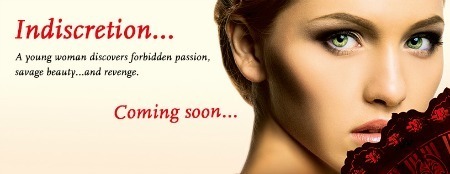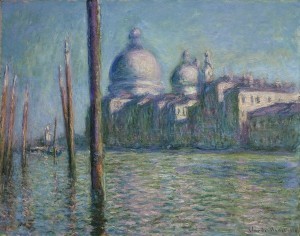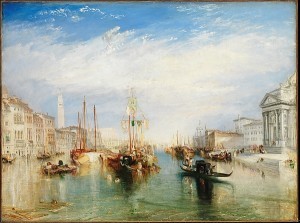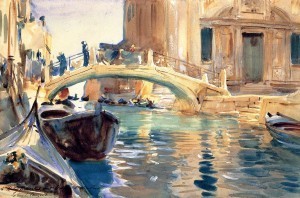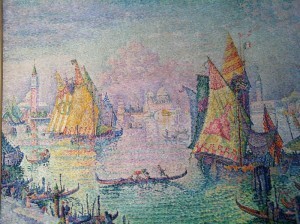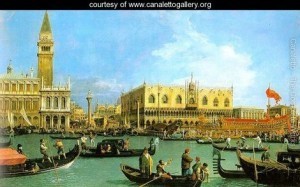Hannah Fielding's Blog, page 90
January 28, 2015
The Lunissanti of Castelsardo
In my novel The Echoes of Love Paolo and Venetia take some time out to get to know each other on the island of Sardinia. There, they attend a very special ceremony in Castelsardo, in the northwest of the island, which is a key part of the town’s cultural identity.
The Lunissanti takes places on the Holy Monday right before Easter, and it involves a procession focused onthe Mysteries, the instruments of the Passion of Christ –different objects relating to Jesus’s crucifixion: the chalice, the glove, the pillar, the chain, the scale, the crown of thorns, the cross, the ladder, the hammer and tongs, the spear and the sponge.
Early in the morning, at sunrise, the people of Castelsardo attend a mass at the Church of Santa Maria. Then the apostuli (those chosen to bear the Mysteries) begin the procession to voices lifted in song provided by the cantori – three choirsof twelve members each, called lu Miserere, luStabat and luJesu.
The procession winds through the streets, lined with people, to its destination: the abbey of Nostra Signora di Tergu. There, the apostuli place the Mysteries in front of the altar, andanother mass is held.
Afterwards, the people feast before the abbey to celebrate the arrival of spring. And then, as the sun lowers in the sky, the procession reforms and returns through now candle-lit streets to the Church of Santa Maria, for a rite of thanksgiving. I describe the scene thus in The Echoes of Love:
Suddenly from afar burst the swelling melody of the Miserere, throbbing through the night, sung by a perfect choir and perfect soloists. An impressive silence blanketed the town while they listened to the exquisitely mournful sound. Soon the procession came marching up the narrow medieval street on their slow way home to the Church of Santa Maria where it had all started at dawn.
Men that were part of the Confraternita di Santa Croce were dressed in white tunics and cloaks with thin, high-tapering hoods… The cowled men and the pilgrims all held torches or candles, the golden glow of which threw a warm tone over the attendant multitude, swarming like bees to get a nearer view. As the procession passed by, the crowds lining the streets fell devoutly upon their knees.
Paolo and Venetia joined the worshippers on their way to the Church of Santa Maria, following the wooden cross and the human skull set on a tray, both carried by the apostles and accompanied by prayers and religious chanting of the three choruses.
There was an intensity about the worship which Venetia had not observed before, even in Spain. It was as if a great mystical shadow was being cast by the twenty-four hooded men and it stirred Venetia’s emotions profoundly. She could well understand how this sort of rite recalling the Passion of Jesus and involving legions of devotees would awaken a lagging faith and leave an indelible and unforgettable impression for all time – for who could ever erase the memory of one of these processions wending its glimmering way at night through the narrow medieval Sardinian streets into the immensity of the dark, waiting church?
‘The Miserere’, to which I refer, is a psalm by the sixteenth-century Italian composer and priest Gregorio Allegri. It really is beautiful, as this video portrays.
This song, and others, are core elements of the Lunissanti, and deeply moving ones. Paolo tells Venetia, ‘It is a profoundly spiritual ritual. I found it cleansing somehow.’ And as she watches him in the church, she sees how engrossed he is in the ceremony, and it touches her. I write:
She had sometimes wondered if Paolo had a faith, and now she found a potential new facet to his personality that intrigued her. Her heart flooded with compassion and love for him. At that moment, she wanted nothing more than to make him happy, to compensate for all the countless years and memories he no longer had.
Perhaps not the most conventional of dates for a courting couple. But I love the connection it creates for them.They are not so much people in that church, they are souls. Soulmates.
January 26, 2015
A novel publicity stunt
 Thriller author James Patterson has long been a vocal advocate of aggressive, creative, attention-grabbing marketing in the publishing industry. He’s famously said: ‘Publishers are sitting around saying: “Woe is me.”… Get in attack mode.’ (Source: The Guardian).
Thriller author James Patterson has long been a vocal advocate of aggressive, creative, attention-grabbing marketing in the publishing industry. He’s famously said: ‘Publishers are sitting around saying: “Woe is me.”… Get in attack mode.’ (Source: The Guardian).
Although Patterson has a publisher, he’s always seen marketing as a personal responsibility as well. With a background in advertising, he saw no reason why his own novels should not be advertised in similar ways to other products. Hence he tried to get his publisher, Little, Brown, to invest in a television advertising campaign for his book Along Came a Spider. The publisher was not convinced: not only was such marketing prohibitively expensive, but it was thought that readers wouldn’t respond well to it. It was just not the done thing. Undeterred, Patterson wrote, produced and paid for a commercial himself. Once the publisher saw the advert, it agreed to part-fund it along with the author, and it was rolled out in New York, Chicago and Washington. The result: Along Came a Spider debuted at number nine on the New York Times hardcover bestseller list, and soon soared to second place.
Ever since that book propelled James Patterson to global success (he’s now published more than 100 books, sold nearly 300 million copies, topped the Forbes list of the highest-paid authors and is the subject of a Harvard Business School study on marketing strategy),when he has a new book coming out, publishing professionals sit up and take notice of the marketing plan for the release. And the newest plan is causing quite a stir!
According to the New York Times, Patterson is offering a novel package to one ardent fan with deep pockets:
The price tag of $294,038 includes a first-class flight to an undisclosed location, two nights’ stay in a luxury hotel, 14-karat gold-plated binoculars, a five-course dinner with Mr. Patterson and a copy of “Private Vegas” that will self-destruct 24 hours after the purchaser begins reading it. While the details of how the book will explode are being kept secret, the process will involve a bomb squad and a location that could come straight out of a Patterson story.
Coupled with this, another 1,000 people will be able to read the book for free via selfdestructingbook.com – but only for a single day: after 24 hours the digital download will self-destruct (delete).
The marketing campaign is certainly novel, and tailored to the genre in which Patterson writes, full of drama and danger. And whether you delight in the idea of a self-destructing book or not, the campaign has already done its job, catching the interest of all the mainstream media, so that doubtlessly when the book is released plenty of people will be interested in it.
I very much admire Patterson for his ingenuity and humour, and for working so hard himself to get word of his books out to readers. He’s a good example for all authors, whether self-published or traditionally published.
If I could arrange publicity events for my novels, I think they would have to incorporate travel, for the locations in which I set my stories are so important. Perhaps I would stage a reading from Burning Embers aboard a hot-air balloon hovering over the African plains. Or perhaps a stunt on a gondola in Venice – I’m imagining lines from the book painted in beautiful script so that the craft is the craft… The possibilities are endless. Perhaps someday, but for now my hands are full preparing my next book, Indiscretion, for publication. Not long to go now!
January 24, 2015
An anonymous artist with a marvellous mission
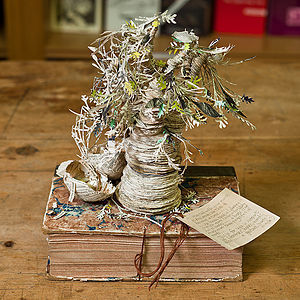 Earlier this week, I posted an article about author James Patterson’s latest publicity stunt: an exploding book. No doubt that book will have his name prominently displayed on it. As for the vast majority of creative – artists, writers, musicians – the name is as big a part of the brand as the work. That name can be very useful in a publicity campaign for a creative work, but also in a broader one to support a good cause. Patterson, for example, took out adverts in major American press in support of bookstores, libraries and publishing houses (see http://jamespatterson.com/reading_who-will-save-our-books.php#.VMEF80esU5o). His adverts courted a lot of attention: the James Patterson effect.
Earlier this week, I posted an article about author James Patterson’s latest publicity stunt: an exploding book. No doubt that book will have his name prominently displayed on it. As for the vast majority of creative – artists, writers, musicians – the name is as big a part of the brand as the work. That name can be very useful in a publicity campaign for a creative work, but also in a broader one to support a good cause. Patterson, for example, took out adverts in major American press in support of bookstores, libraries and publishing houses (see http://jamespatterson.com/reading_who-will-save-our-books.php#.VMEF80esU5o). His adverts courted a lot of attention: the James Patterson effect.
But can you spark discussion and get attention for a cause without a big name? Yes, absolutely, as one amazing sculptor has been demonstrating in Scotland over the past three years. The artist has been creating intricatesculptures from old books, and leaving them around to be discovered in places that relate to her mission: ‘in support of libraries, books, words and ideas’. She left two at the Edinburgh Book Festival, for example, and another at the Robert Burns Birthplace Museum. Her wonderful art and the mystique that surrounds it have attracted a good deal of publicity worldwide. But the sculptor herself? Entirely anonymous.
This month she granted the BBC an interview via email. She explained that she chooses places that she loves in which to leave her works, and makes the pieces to suit the places, including in each work a tag to illustrate the thinking behind the art. ‘The book sculptures were there, I suppose,’ she said,‘to make you read the tag.’ As an example, a tag on her now-famous butterflies sculpture includes the quotation: ‘We delight in the beauty of the butterfly, but rarely admit the changes it has gone through to achieve that beauty’ (Maya Angelou).
When asked why she remains anonymous, the artist replied: ‘Why would you focus on one ordinary individual? Libraries, galleries, museums etc are a better focus and a lot less ordinary.’ All she has said of herself is that she is ‘a woman, who had been a girl, whose life would have been less rich had she been unable to wander freely into libraries, art galleries and museums’.
No doubt the anonymity of the artist contributes to the reach of her work and her message. In today’s culture of celebrity, it is fascinating to find someone whose work is so acclaimed but who does claim any credit for it; to find art that speaks for itself, without any backstory or spin. The artist does not even use a pseudonym, or have a site to publicise her works. She reports that she does not even care whether some of her art, which she leaves without announcement, are never found. It is a powerful statement to make in the arts world.
January 22, 2015
My new novel – coming soon!
January 21, 2015
Book-spotting in London
It’s a most rewarding activity which I think most published authors would admit to indulging in: looking for your book on the shelves of bookstores wherever you go. This week, with the help of some friends who commute around London, I’ve book-spotted The Echoes of Love in three locations, Heathrow, Victoria and St Pancras – in the bestsellers’ chart of WH Smiths. If you happen across one of my novels while book-spotting, I would love to know about it! Feel free to post the location here.
Five fine art depictions of the Venetian waterscape
When I think of Venice, setting for my novel The Echoes of Love, I always think of two things: art and water. Venice has long been an important focus in the art world, especially during the Middle Ages, Renaissance and Baroque; it even boasted its own unique style known as the Venetian School, whose major artists were Titian, Tintoretto, Veronese and the Bassano. And, of course, Venice is the city of waterways, home to the iconic gondola.
Today I am sharing with you ten of my favourite depictions of the city I love so well with a focus on the waterscape. Which painting most inspires you and makes you want to travel to Venice?
1. Monet’s Le Grand Canal ( 1908)
I love the dreamy quality to this work. The founder of French Impressionist painting created this while on a three-month trip to Venice in 1908. It was first exhibited in 1911 in a show dedicated to the 37 paintings he completed with the city as subject. Next month this painting will be auctioned by Sotheby’s, and it is estimated to sell for between £20and £30 million.
2. Turner’s Venice, from the Porch of Madonna dellaSalute (1835)
The buildings seem to melt into the water here. Turner was a Romanticist landscape painter, and what better landscape for a Romanticist than Venice! He travelled widely in Europe, and went to Venice several times. He first exhibited this oil painting at the Royal Academy, London, to great acclaim. It’s now on show at the Met.
3. John Singer Sargent, Ponte San Giuseppe di Castello (1903)
Sargent travelled extensively, and found inspiration in Venice from the artists of the city. ‘I have learned in Venice to admire Tintoretto immensely and to consider him perhaps second only to Michelangelo and Titian,’ he wrote after one visit. He painted hundreds of watercolours of Venice that, like this one, are wonderfully vivid.
4. Paul Signac’s The Lagoon of Saint Mark, Venice (1905)
This painting, by one of the most influential Neo-Impressionist painters, is heralded as a superb example of pointillism and color theory experimentation. Signac wrote, ‘It is through the harmonies of lines and of colors…not through the subject that the painter ought to stir the emotions.’ In this painting, I think he achieves just that. You can find the original at the the Chrysler Museum of Art.
5. Canaletto’s The Molo, Seen from the San Marco Basin, 1730
Canaletto loved this view so much that he painted ten versions of this work.I love the sense of light in the scene, and the realism, plus the inclusion of the iconic San Marco Basilica and Campanile. The painting is part of the permanent collection at the Louvre, Paris. I have seen it there, and I found it very moving.
January 18, 2015
The writer’s responsibility to write well
 I make it my business to know about the publishing industry, and to keep abreast of news and opinion pieces in the book sections of newspapers and in magazines dedicated to the theme. Of course, much has changed and is changing in this sector, and so people have much to say. But one theme that keeps jumping out at me is this:
I make it my business to know about the publishing industry, and to keep abreast of news and opinion pieces in the book sections of newspapers and in magazines dedicated to the theme. Of course, much has changed and is changing in this sector, and so people have much to say. But one theme that keeps jumping out at me is this:
The decline of the old-school in-house editor.
Back in the day, a publishing editor’s role was to spot talent and then, if necessary, help the author to hone that talent. So part of the editor’s role was to direct the author on revisions, and to edit rigorously, sometimes over a long period of time.
Today, publishing is more corporate. Money and time matter. An editor wants to buy a book that’s ready to go – or just about. Authors are expected to submit manuscripts that have already been rigorously revised, developed, copy-edited and proofread. Then the editor can take over the book, make the odd tidy and then send it, quickly, to the production team to get into print.
A new film due out in 2015 called Genius (starring Jude Law and Colin Firth) will be focusing on the halcyon days of the hands-on editor. The lead character is based on renowned literary editor Max Perkins, who worked for Scribner and edited the works of Thomas Wolfe, Ernest Hemingway and F. Scott Fitzgerald,among others. The story follows his work with Thomas Wolfe, who was an early talent in autobiographical fiction.
Writing Magazine (February 2015) has explored what that must have been like for Perkins. Wolfe’s first draft was 335,000 words – more than three times longer than the current average novel – and Perkins was tasked with directing Wolfe in cutting it right down. Wolfe, apparently, was not up to the job: if Perkins got him to agree to cut a few thousand words, Wolfe would then write double that number and insist they must be added. Finally, after a good deal of stress, Perkins handed the finished manuscript over to be published: all 245,000 words.
Today, editors just don’t have the time to put in the kind of effort that Perkins did. I wonder: is that a good or a bad thing? On the negative side, all books benefit from long-term, rigorous editing by an experienced editor – and sometimes the corporate rush can have a detrimental effect on quality. But on the other side, the reduced role of the in-house editor forces authors to take more responsibility themselves for writing well, which is surely a very good thing.
Authors today are much more professional than they were in ‘the good old days’ for one central reason: we have to market. Any author signed to a publisher must market his or her book energetically. We must be on Twitter and Facebook and Goodreads. We must engage in giveaways and write guest posts and interviews for bloggers. We must do myriad activities to support our publishers in selling our books. (We are no different to self-publishing authors in that sense.) The modern author is a businessperson. And with that role comes a willingness to work hard and to care about the quality of the product. So, the modern author conducts rigorous editing him- or herself, and perhaps works privately with an editor before submitting the manuscript to the publisher’s editor.
For me, it’s a joy working to create the very best book I can myself. It’s a source of personal pride. I see itasmy responsibility as well – being a writer is my job, and I take that seriously.
In his time people called Thomas Wolfe a genius, which is a word that suggest innate brilliance that requires no work. But clearly, he did need to work on his writing – and later in his career he came to see how much he needed Perkins’ editing expertise. There is no genius in writing, I think. There is only very, very hard work and a passion for the craft.
January 17, 2015
Is always having a new book to read important to you?
 There’s a new word being bandied about online and in writing magazines:
There’s a new word being bandied about online and in writing magazines:
Abibliophobia.
The definition is ‘a fear of running out of reading material’. The word is being treated as something of a joke – a humorous witticism. But I think there is a lot of truth in it!
For the avid reader, nothing is better than starting a new book and realising that it is one you will enjoy. But on the flip side, nothing is worse than nearing the end of that book and knowing you will have to let go of the story world and return to reality. For me, there’s a sort of grieving that takes place after I finish a good book. The glow of having enjoyed it stays with me, but there’s a tinge of regret that the experience is over, and never again will I read that wonderful book for the first time and discover afresh.
When you really love to read, the only thing that can get you through the emotional journey of reading, I think, is to always have the next book ready. So even as you’re enjoying your book, you go to the library and find another that interests you, or you browse in a bookstore for a novel that captures your imagination. Then the reading becomes even better, because not only are you enjoying the book you are reading now, but you are simultaneously looking forward to reading the next book.
But is just one book lined up to read next enough? For me, no! I read quickly: something in the region of a book a week; sometimes more. So that moment of finishing a novel and feeling bereft comes often. To assuage concern, I like to have a good pile of books on the ‘to read’ pile. Five at least. More is a comfort. And when I travel, those books have to be packed up and come with me – even if I doubt I will have the time to get through them. They are my safety net; they are too important to leave behind.
I was fascinated to watch a segment on the BBC’s One Show recently that featured a couple, Bill and Laurel Cooper, who spent 36 years sailing around the world together after their children had left home. Laurel, a keen reader, insisted that the boat be fitted out with a library for her books. She said, ‘I couldn’t do without my books.’ The books weighed a lot and affected how low down in the water the craft sat – but she was adamant she must have them. I would be entirely the same, and would probably have to research means to get new reading material on the course of the adventure as well!
(The episode is available to watch for the next few weeks at http://www.bbc.co.uk/programmes/b04xm4pf– if you can take a look, I really recommend it. Their story is really inspiring. You can also read about them here: http://www.dailymail.co.uk/news/article-2106969/Bill-Laurel-Cooper-The-adventures-couple-spent-36-years-travelling-world.html.)
What do you think? Are you an abibliophobe? Is that a problem for you, or a sheer delight? I would love to hear your thoughts.
January 14, 2015
The ultimate Italian delicacy: the white truffle
 In my novel The Echoes of Love – set in Venice, Tuscany and Sardinia – the lovers, Venetia and Paolo, share several meals out together, from fine dining in a celebrated restaurant to authentic cuisine in a rustic local eatery, and on the menu are all kinds of delicious Italian dishes. Venetia and Paoloknow good food, and in that sense there is a lot of myself and my husband in the characters. Whenever we travel, we love to discover the best places to eat, whether they are in the heart of the city and managed by a famous chef or, preferably, off the beaten track and frequented by locals. Near where we live in Ste Maxime in France we go to several such little gems. I won’t share the names here – they’re our little secrets!
In my novel The Echoes of Love – set in Venice, Tuscany and Sardinia – the lovers, Venetia and Paolo, share several meals out together, from fine dining in a celebrated restaurant to authentic cuisine in a rustic local eatery, and on the menu are all kinds of delicious Italian dishes. Venetia and Paoloknow good food, and in that sense there is a lot of myself and my husband in the characters. Whenever we travel, we love to discover the best places to eat, whether they are in the heart of the city and managed by a famous chef or, preferably, off the beaten track and frequented by locals. Near where we live in Ste Maxime in France we go to several such little gems. I won’t share the names here – they’re our little secrets!
In Mediterranean cooking, the ingredients matter most, closely followed by simplicity in the recipe, the presentation and the eating. Could I have fitted another visit to a restaurant into Venetia and Paolo’s story, I know where I would have sent them – a little-known family-run restaurant in the Tuscan-Romagnol Apennines that specialises in the most delicious of all the Italian delicacies: the white truffle.
French gourmand Jean Anthelme Brillat-Savarin famously declared truffles‘the diamond of the kitchen’, and I think he was right. They are luxurious and exceptionally exclusive and expensive. Surprising, really, when you reflect that they are fungi that grow around the roots of trees– but when you taste them… oh! Then you understand.
Then trifolad’Alba Madonna (white truffle) grows in the Piedmont region in northern Italy, in the wilds around Alba and Asti, and in the setting for The Echoes of Love: Tuscany. They’re by no means large, but my goodness are they valuable. The weightiest truffle is usually no more than 500 grams, and that single truffle may sell for $1,000 to $2,250 – or even more; in December 2009 truffles were being sold at $14,000 per kilo!
Truffle hunting and marketing is a subject for the record books. Casino owner Stanley Ho, for example, made history in 2007 when he paid $330,000 for a 1.5-kilo truffle – and then in 2010 he spent $330,000 for a pair coming in at just under a kilo. So popular are the Italian truffles that people flock internationally to specialist truffle fairs such as that held in Alba from early October through to mid-November. I attended one such fair and it was wonderful – the scent of truffles in the air; the chance to sample dishes that would cost a small fortune in New York or London or Paris; and of course the air of festivity and revelry that comes with all Italian fieras.
What makes truffles so precious? Their rarity. Way back in 1825 French gastronome Jean-Anthelme Brillat-Savarin best expressed it:
The most learned men have sought to ascertain the secret, and fancied they discovered the seed. Their promises, however, were vain, and no planting was ever followed by a harvest. This perhaps is all right, for as one of the great values of truffles is their dearness, perhaps they would be less highly esteemed if they were cheaper.
He also famously said: ‘Tell me what you eat, and I will tell you what you are.’ Perhaps another reason to eat truffles!
So how does one sample a truffle? Well, the best I’ve ever tasted were with hot, buttery pasta. They are served raw, shaved into small pieces. I’ve also tried them with meat, and I believe you can get special truffle cheeses. But such dishes come at quite a price in the busy city restaurants. A good way to get the taste of truffles without breaking the bank is to try truffle oil, which adds wonderful flavour to dishes. (Do beware, though, that the cheap truffle oils are often synthetic and actually contain olive oil and no truffles at all.) Drizzling the oil over pasta dishes, meat and pizza, and using it to fry vegetables and French fries,are becoming increasingly popular.
So there you have it, the white truffle. I have shared a picture with you here so that you can easily identify it, with a particular news story in mind. Recently, a customer in a Washington restaurant made a costly mistake: she ate $300-worth of a truffle without even knowing what it was. The restauranteurwas displaying the truffle proudly on a counter, and the customer took a bite, thinking it was a few appetiser. Oops!
January 12, 2015
The Facebook Book Club
 Mark Zuckerberg, founder of Facebook, is a game changer. So when he does something new, people sit up and take notice. How interesting, then, for we who are immersed in publishing, that his new initiative is in our camp: he just launched The Year of Books Community on Facebook to fulfil his New Year’s resolution to read a book each fortnight.
Mark Zuckerberg, founder of Facebook, is a game changer. So when he does something new, people sit up and take notice. How interesting, then, for we who are immersed in publishing, that his new initiative is in our camp: he just launched The Year of Books Community on Facebook to fulfil his New Year’s resolution to read a book each fortnight.
Zuckerberg’s annual resolution is notorious for being somewhat zany. As the Independent newspaper recently reported:
The 30-year-old billionaire is known for making New Year’s resolutions that are by turns banal and bizarre. In the past he has undertaken to meet a new person every day for a year, to write a daily thank-you note, and to wear a tie every day. One year, Mr Zuckerberg vowed to learn Mandarin. Another, he announced that he would only eat meat from animals that he had killed himself, and enlisted a local chef and butcher to facilitate the process.
This year, the Facebook founder asked for suggestions from his followers for a resolution, and he picked wisely. He offers the following as a mission statement for his club:
We will read a new book every two weeks and discuss it here. Our books will emphasize learning about new cultures, beliefs, histories and technologies. Suggestions for new books to read are always welcome. We ask that everyone who participates read the books and we will moderate the discussions and group membership to keep us on topic.
Essentially, although Zuckerberg is careful to avoid the term, this is a book club. A very big book club – perhaps the biggest in the world – because at the time of writing already 210,000 people have joined.
I very much like Zuckerberg’s spirit with this endeavour, but I do wonder whether he has opened a can of worms in terms of choosing the books to read and discuss. A new book every fortnight equates to 26 books a year. That is a tiny drop in a very large ocean of books that are published.
I can envision the community being inundated with publishers and authors offering their wares; already plenty are doing so. And the reason is clear: this brand-new book club is already one of the most powerful in the world. The first book on the list for the year, The End of Power by MoisésNaím, sold out on Amazon.com in 24 hours. Clearly, like Oprah, Zuckerberg has the power to wave a magic wand and make a book a bestseller.
I wonder how the author feels. A little overwhelmed by the speed, perhaps! And the publisher? Perhaps a little disappointed that it didn’t get advance notice so that it could plan for the deluge of sales. Jim Milliot, editorial director at Publisher’s Weekly, said on the subject of the Facebook club versus Oprah’s: ‘For one thing, Zuckerberg hasn’t worked with the publishers yet to help facilitate sales.’ The word ‘yet’ is interesting. There is an assumption that publishers will be supported to use this venture to their own gain. But perhaps Zuckerberg thinks otherwise. Perhaps this club is not about which publisher carries the most clout, but about some genuine book choices by readers. Grass roots. Very, very interesting.
It remains to be seen whether those who are joining the book club will stick with it – reading the books and actively discussing them. But the wave of new joiners is indicative of a shift to digital for readers – to discover books, to read books and to talk about books. What’s most exciting, I think, is how sharing recommendations on social media can bring books to the fore.
On Twitter, for example, you can explore various reading hashtags as a means to find new books. I like the #amreading one, and of course #fridayreads has long been popular. Twitter has a lot of potential for readers and writers alike. Did you know, for example, that John Green’s A Fault in Our Stars was the most discussed book of last year on Twitter, with some 1.4 million mentions?
It’s surely enough to take the wind out of the sails of those who bemoan the growth of digital for its effect on the book. In so many ways digital is getting people sharing stories, and that trend can only go one way: up.


